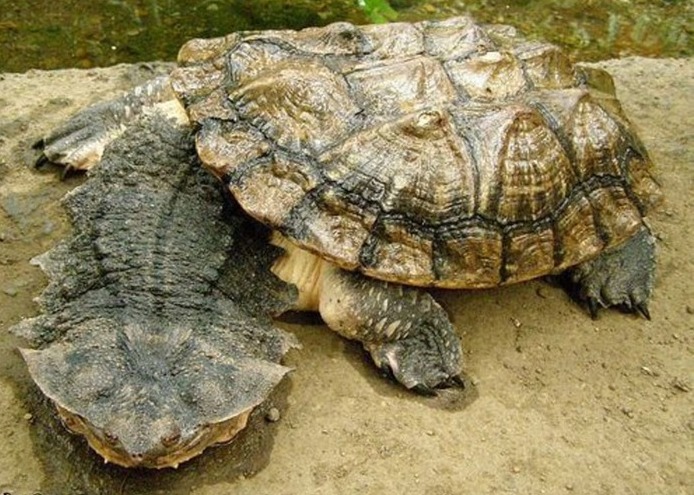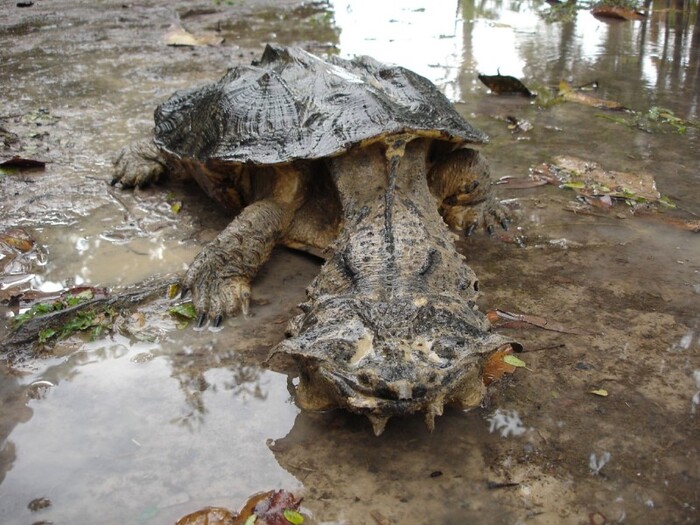The Mata Mata turtle (Chelus fimbriata), mata mata, mata-mata, or matamata .is a remarkable and highly specialized species of freshwater turtle that inhabits the slow-moving rivers, swamps, and creeks of the Amazon and Orinoco basins in South America. Known for its striking appearance and unique adaptations to its environment, the Mata Mata has intrigued both scientists and the public alike. This comprehensive article delves into the species' morphological characteristics, ecological role, behavior, and conservation status, as well as the threats it faces in the wild.
Kingdom: Animalia
Phylum: Chordata
Class: Reptilia
Order: Testudines
Family: Chelidae
Genus: Chelus
Species: Chelus fimbriata
This classification places the Mata Mata turtle firmly within the broader context of reptilian life, specifically within the diverse and unique group of turtles that inhabit South America. Its classification highlights its evolutionary relationships and distinctive characteristics, especially its unique ecological adaptations in aquatic environments.
The Mata Mata turtle is immediately recognizable due to its extraordinary and often bizarre appearance, which serves as an adaptation to its environment.

Head and Neck: The Mata Mata's most distinguishing feature is its large, triangular head covered with a flap of fleshy skin. This feature aids in camouflage, allowing the turtle to blend seamlessly into the aquatic vegetation of its habitat. The neck is long, flexible, and lined with folds of skin, enhancing its ability to remain motionless while hunting.
Shell: The shell is flat, wide, and roughly textured, providing a stable surface for the turtle to rest on in the soft, muddy bottoms of slow-moving rivers. The carapace (upper shell) can grow up to 50 cm in length, while the plastron (lower shell) is much smaller.
Coloration: The Mata Mata turtle is typically dark brown or grayish-brown, with darker markings along the edges of the shell, which help it blend into the riverbed. This coloration, coupled with its body shape, contributes to its effective camouflage in murky waters.
Body Length: Adult Mata Mata turtles range from 40 cm to 50 cm in shell length, though larger individuals have been recorded in captivity.
Weight: These turtles can weigh up to 15 kg (33 lbs), with females typically being larger than males.
Lifespan: In captivity, Mata Mata turtles can live for over 40 years, though their lifespan in the wild remains uncertain due to limited long-term data.
The Mata Mata turtle is endemic to the Amazon and Orinoco basins in South America. These regions offer the perfect environment for this turtle’s specialized way of life.
Water Type: Mata Mata turtles are found in slow-moving rivers, swamps, and creeks with soft, acidic water, usually containing abundant aquatic plants and low to moderate currents. They are typically found in waters with low oxygen content.
Temperature: Being a tropical species, Mata Mata turtles prefer waters with temperatures ranging from 24°C to 30°C (75°F to 86°F), which aligns with their need for a warm and stable aquatic environment.
Vegetation: Dense aquatic vegetation is critical for both camouflage and feeding, as the turtles often remain motionless, relying on their cryptic appearance to catch prey by surprise.
Their reliance on specific habitats makes them highly vulnerable to changes in their environment, such as deforestation and river damming, which can disrupt water flow and reduce habitat availability.
The Mata Mata turtle is an ambush predator and plays a unique role within its aquatic ecosystem.
Carnivorous Diet: Mata Mata turtles primarily feed on small aquatic vertebrates, including fish, amphibians, and invertebrates. They may also consume small crustaceans and insect larvae.
Feeding Strategy: Unlike many other turtle species, the Mata Mata employs a slow and stealthy feeding strategy. With its long, flexible neck and slow-moving mouth, it can remain motionless for extended periods while waiting for prey to approach. The turtle then uses its rapid neck extension to ambush and catch unsuspecting fish or other small creatures.
Metabolism: The Mata Mata has a relatively slow metabolism, which is typical of species that live in environments with low oxygen or nutrient-poor waters. This allows it to survive in areas where other aquatic species might struggle.
Reclusive Nature: Mata Mata turtles are largely solitary and prefer to stay hidden in vegetation or submerged in mud and leaves, where they are difficult to detect.
Slow Movements: Their movements are deliberate and unhurried, which aids in conserving energy and reducing their visibility to both prey and predators.
Territorial Behavior: While not overtly territorial, these turtles can be territorial in confined spaces, especially when resources like food or resting areas are scarce.
Mata Mata turtles reproduce sexually and are oviparous. They engage in seasonal breeding, with mating and egg-laying occurring during the rainy season.
Mating Season: Mata Mata turtles breed during the wet season when water levels rise, increasing available food resources. This is typically between December and March.
Courtship: While courtship behaviors are not well-documented, males are believed to court females by gently nudging them and performing swimming displays.
Eggs: The female lays 6 to 12 eggs in a clutch, which she buries in soft, moist soil near the riverbanks. The eggs are leathery, not hard-shelled, which is characteristic of many freshwater turtle species.
Incubation Period: The eggs incubate for about 2 to 4 months, depending on environmental conditions like temperature and moisture. The hatchlings emerge during the rainy season, when they are more likely to find food and shelter.
Juveniles: Once hatched, the young turtles are immediately independent and must fend for themselves, though survival rates for hatchlings are relatively low due to predation from birds, larger fish, and other animals.
The Mata Mata turtle is currently classified as Least Concern by the IUCN Red List due to its relatively stable population. However, it faces several potential threats that could impact its long-term survival.
Habitat Destruction: The expansion of agriculture, urbanization, and deforestation in the Amazon and Orinoco basins has led to habitat degradation and fragmentation. The destruction of wetlands and riparian zones directly affects the turtle's habitat.
Pollution: Water pollution, including the introduction of agrochemicals and plastics, poses a threat to the health of Mata Mata turtles, particularly in rivers with lower water quality.
Illegal Pet Trade: The Mata Mata turtle is a sought-after species in the exotic pet trade. Illegal collection of wild individuals, especially juveniles, for the pet market places considerable pressure on local populations.

Habitat Protection: Efforts are being made to protect key areas of the Amazon and Orinoco basins through the establishment of protected areas and conservation agreements with local communities.
Research and Monitoring: Ongoing research is essential to better understand the turtle’s population dynamics, reproductive habits, and environmental needs.
Regulation of Trade: Legal frameworks aimed at regulating the trade of wild-caught reptiles have been enacted in several countries, with varying levels of enforcement.
The Mata Mata turtle plays an integral role in its ecosystem, maintaining the balance of aquatic food webs and helping to control the populations of small fish and invertebrates.
Bioindicator: Because of its reliance on clean, slow-moving waters, the Mata Mata turtle is often considered a bioindicator species, signaling the health of its aquatic environment.
Food Chain Position: As a carnivore, it helps regulate populations of small aquatic organisms, maintaining the ecological balance of its habitat.
In South American indigenous cultures, the Mata Mata turtle holds cultural significance, often appearing in mythologies and folklore. Its unusual appearance and secretive nature contribute to its mystical reputation among local tribes.
The Mata Mata belongs to the family Chelidae, which consists of several species of freshwater turtles found primarily in South America.
Yellow-Spotted Amazon River Turtle (Podocnemis unifilis): A species that inhabits the same river systems but has a more streamlined appearance.
Brazilian River Turtle (Phrynops hilarii): Another member of the Chelidae family with similar ecological adaptations but a different body shape.
| Species Name | Habitat | Size | Distinctive Characteristics |
|---|---|---|---|
| Mata Mata Turtle | Amazon and Orinoco | 40–50 cm | Large, flat, triangular head, long flexible neck |
| Yellow-Spotted Turtle | Amazon River | 35–45 cm | Bright yellow spots, more domed shell |
| Brazilian River Turtle | South American Rivers | 25–35 cm | Streamlined body, smoother carapace |
The Mata Mata turtle is one of the most ecologically fascinating reptiles in the world, owing to its unique physical traits, specialized feeding techniques, and important role in its aquatic habitat. While the species currently enjoys a Least Concern conservation status, it faces ongoing threats, particularly from habitat destruction and the illegal pet trade. Protecting the Mata Mata turtle requires a combined effort of habitat conservation, enforcement of wildlife protection laws, and scientific research. By ensuring the survival of this remarkable species, we help preserve the complex ecosystems of the Amazon and Orinoco basins, which are home to a vast diversity of wildlife.
animal tags: Chelidae
We created this article in conjunction with AI technology, then made sure it was fact-checked and edited by a Animals Top editor.